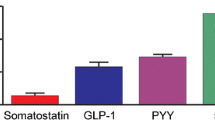Summary
The large intestine resected from 6 Hirschsprung's patients and surgical colonic biopsies from 6 control children were examined with light and electron microscopy. The presence and the relative distribution of various endocrine cell types in both groups of mucosa were determined. In light microscope studies endocrine cell data were expressed as number of cells per unit area of mucosa using a quantitative method after argentaffin and Grimelius's argyrophilic techniques and an immunoperoxidase reaction with glucagon and somatostatin (SRIF) antisera.
The results indicate that endocrine cells are apparently not involved in Hirschsprung's disease, since their number and frequency did not differ significantly between the ganglionic and aganglionic segments of Hirschsprung's patients nor between the latter and control children. Glucagon immunoreactive cells were, on the average, 5–6 times and 7–9 times more numerous that SRIF cells in the rectum and the sigmoid, respectively. Ultrastructurally, five endocrine cell types could be distinguished. The fifth type, probably a transition type, apparently disappears in adults.
Similar content being viewed by others
References
Andrew, A.: The origin of intramural ganglia. IV. The origin of enteric ganglia: a critical review and discussion of the present state of the problem. J. Anat. 108, 169–184 (1971)
Andrew, A.: Further evidence that enterochromaffin cells are not derived from the neural crest. J. Embryol. exp. Morph. 31, 589–598 (1974)
Baumgarten, H.G., Holstein, A.F., Stelzner, F.: Nervous elements in the human colon of Hirschsprung's disease. Virchows Arch. Ab. A path. Anat. 358, 113–136 (1973)
Bodian, M., Stephens, F.D., Ward, B.C.H.: Hirschsprung's disease and idiopathic megacolon. Lancet 1, 6–11 (1949)
Capella, C., Solcia, E., Frigerio, B., Buffa, R.: Endocrine cells of the human intestine. An ultrastructural study. In: Endocrine gut and pancreas, ed. by Fujita, T., pp. 42–59. Amsterdam-New York: American Elsevier 1976
Cristina, M.L., Lehy, T., Zeitoun, P., Dufougeray, F.: Fine structural classification and comparative distribution of endocrine cells in the normal human large intestine. Gastroenterology (In press) (1978)
Ehrenpreis, T., Pernow, B.: On the occurrence of substance P in the rectosigmoid in Hirschsprung's disease. Acta physiol. scand. 27, 380–388 (1952)
Forssmann, W.G., Yanaihara, N., Helmstaedter, V., Grube, D.: Differential demonstration of the motilin cell and the enterochromaffin cell. Scand. J. Gastroent. 11, Suppl. 39, 43–45 (1976)
Forssmann, W.G., Helmstaedter, V., Chance, R.E.: Ultrastructural and immunohistochemical demonstration of pancreatic polypeptide containing F cells in the stomach and pancreas of Tupaia belangeri. Cell Tiss. Res. 177, 481–492 (1977)
Grimelius, L., Capella, C., Buffa, R., Polak, J.M., Pearse, A.G.E., Solcia, E.: Cytochemical and ultrastructural differentiation of enteroglucagon and pancreatic-type glucagon cells of the gastrointestinal tract. Virchows Arch. B Cell Path. 20, 217–228 (1976)
Heitz, Ph., Polak, J.M., Timson, C.M., Pearse, A.G.E.: Enterochromaffin cells as the endocrine source of gastrointestinal substance P. Histochemistry 49, 343–347 (1976)
Knudsen, J.B., Holst, J.J., Asnaes, S., Johanssen, A.: Identification of cells with pancreatic-type and gut-type glucagon immunoreactivity in the human colon. Acta path. microbiol. scand. Sect. A 83, 741–743 (1975)
Le Douarin, N.M., Teillet, M.A.: The migration of neural crest cells to the wall of the digestive tract in avian embryo. J. Embryol. exp. Morph. 30, 31–48 (1973)
Lin, T.M., Chance, R.E.: Candidate hormones of the gut. VI. Bovine pancreatic polypeptide (BPP). Gastroenterology 67, 737–738 (1974)
Moxey, P.C., Trier, J.S.: Endocrine cells in the human fetal small intestine. Cell Tiss. Res. 183, 33–50 (1977)
Nilsson, G., Larsson, L.L., Hakanson, R., Brodin, E., Pernow, B., Sundler, F.: Localization of substance P-like immunoreactivity in the mouse gut. Histochemistry 43, 97–99 (1975)
Okamoto, E., Ueda, T.: Embryogenesis of intramural ganglia of the gut and its relation to Hirschsprung's disease. J. Pediatr. Surg. 2, 437–443 (1967)
Pearse, A.G.E.: The cytochemistry and ultrastructure of polypeptide hormone-producing cells of the APUD series and the embryologic, physiologic and pathologic implications of the concept. J. Histochem. Cytochem. 17, 303–313 (1969)
Pearse, A.G.E.: Cell migration and the alimentary system: endocrine contributions of the neural crest to the gut and its derivatives. Digestion 8, 372–385 (1973)
Pearse, A.G.E., Polak, J.M.: Immunocytochemical localization of substance P in mammalian intestine. Histochemistry 41, 373–375 (1975)
Pearse, A.G.E., Polak, J.M., Bloom, S.R.: The newer gut hormones: cellular sources, physiology, pathology and clinical aspects. Gastroenterology 72, 746–761 (1977)
Pearse, A.G.E., Takor Takor, T.: Neuroendocrine embryology and the APUD concept. Clin. Endocr. 5, 229s-244s (1976)
Polak, J.M., Heitz, Ph., Pearse, A.G.E.: Differential localization of substance P and motilin. Scand. J. Gastroent. 11 Suppl. 39, 39–42 (1976)
Smith, B.: Hirschsprung's disease. In: The neuropathology of the alimentary tract. ed. by Smith, B., pp. 68–80. London: Edward Arnold Ltd. 1972
Swenson, O., Rheinlander, H.F., Diamond, I.: Hirschsprung's disease: a new concept of the etiology. New Engl. J. Med. 241, 551–556 (1949)
Tafuri, W.L., Maria, T.A., Pittella, J.E.H., Bogliolo, L., Hial, W., Diniz, C.R.: An electron microscope study of the Auerbach's plexus and determination of substance P of the colon in Hirschsprung's disease. Virchows Arch. A path. Anat. Histol. 362, 41–50 (1974)
Tobe, T., Fujiware, M., Tanaka, C.: Distribution of serotonin in the human gastrointestinal tract. Cellular localization by means of Falck's fluorescence method. Amer. J. Gastroent. 46, 34–37 (1966)
Van Campenhout, E.: Further experiments on the origin of the enteric nervous system in the chick. Physiol. Zool. 5, 333 (1932)
Weichert, R.F.: The neural ectodermal origin of the peptide-secreting endocrine glands. Amer. J. Med. 49, 232–241 (1970)
Whitehouse, F.R., Kernohan, J.W.: Myenteric plexus in congenital megacolon. Arch. intern. Med. 82, 75–111 (1948)
Yntema, C.L., Hammond, W.S.: The origin of intrinsic ganglia of trunk viscera from vagal neural crest in the chick embryo. J. comp. Neurol. 101, 515 (1954)
Author information
Authors and Affiliations
Rights and permissions
About this article
Cite this article
Cristina, M.L., Lehy, T., Voillemot, N. et al. Endocrine cells of the colon in Hirschsprung's and control children. Virchows Arch. A Path. Anat. and Histol. 377, 287–300 (1978). https://doi.org/10.1007/BF00507130
Received:
Issue Date:
DOI: https://doi.org/10.1007/BF00507130




